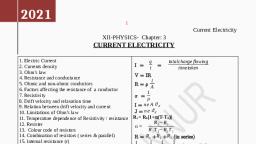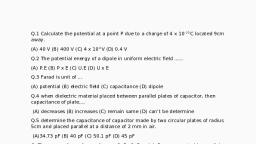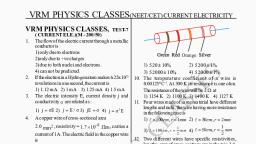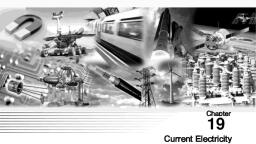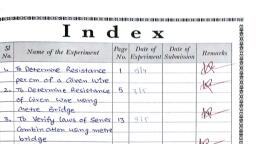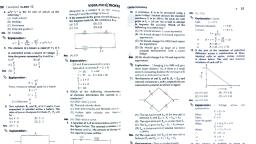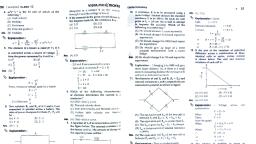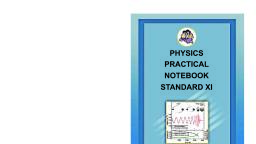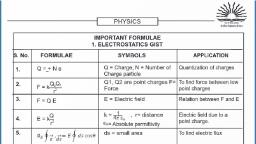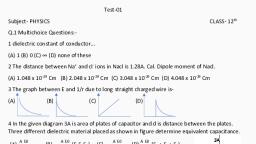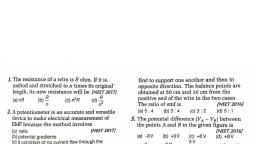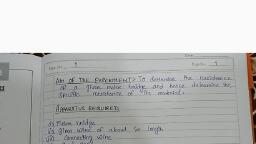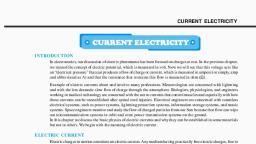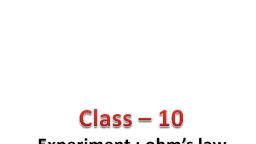Page 1 :
cE § Paget =, , , , EEE Electricity B, EXPERIMENT - 1, , Aim- To find the resistance of a given wire using metre bridge, and hence determine the specific resistance of its material., Apparatus required- Meter bridge, Galvanometer, resistance box, (10-15 Ohm) resistance wire, connecting wires, key, lechlanche, cell, screw ganuge etc., , Theory and Formula- Metre bridge, works of the principal of, wheatstone bridge, circuit of meter bridge is shown as given figure., Resistance of AB part of the wire is P. Resistance of BC part of the, wire is Q, Resistance of AD part of the wire is known resistance R, and resistance of DC part of the wire is unknown resistance S. In, this way, in metre bridge also there are four resistances P, Q, R, and 8. Cell E and galvanometer G are connected between AC and, BD respectively., , , , , , , , , , , , , , , , , , , , , , , , , , , , , , , , , , , , , , , , , , , , , , , , , Fig. Meter bridge, Let the position of balance from point A to B,i.e., cm., , G.P.H. Practical Physics - 12/5, , PHYSICS (Practical), , eee g = Rxttoo=9, , S ~ 100-2 7, By the help of above formula we can find the value of unknown, resistance S., Now if the total length of the unknown resistance wire is L and, radius is r then,, BoE ms, Seige pa z, Method- (1) First ofall a circuit made according to the figure. R is, the resistance box. Which is placed between screws F and G., , , , , , , , , , , , unknown resistance is E Ki, connected between H and I. = (= (ox, Connecting screw D is, , connected to a galvanometer, , and then to the jockey B. Acell D, , is connected between points A R a, , and C with key K,., , (2) Now check the circuit, for, , that we take out a resistance Ky Cc, from the resistance box is2ohm “ P, , or3 ohm. Now press the jockey pf (100-4), , first at A and then at C. Note, down the deflection in the, galvanometer. If they are, opposite, then we can say that the connections are correct., , (3) Now take out a known value of resistance from resistance box., Press the jockey near at A. Let the deflection be on the lefi, move, , ittowards the centre of the wire. We will find the deflection becomes., zero. Note down the position of null point from end A with the, , help of meter scale., , (4) Repeat the same procedure for different values of resistance, , when taken out from resistance box and find out the position of, null point., , (5) When the changed of the position of resistance box and, , unknown resistance wire. And repeat the same procedure for same, Tesistance in serially. When the deflection becomes zero. Note down, the position of null point from end A with the help of meter scale., , , , , ae brid:, , , , , , , , , , When the, is connec, , , , , , , , , , , c Length | (100 — /) S=, é ¢ in the . (100—¢), as (100—/) position a. pea,, , of zero., , , , , , , , , , , , , , , , , , , , , , (cm.) (ohm) (ohm), 38.2 3.71 3.70, 429 3.72 3.70, 48.1 3.70 3.70, 55.3 3.71 3.70, 65.0 3.71 3.70, 78.8 3.72 3.70
Page 2 :
a, , , , , , , , , , , , , , , , , , , , , , , , , , , , , , , , , , , , , , , , , , , 6 / GP.H, Practical Physics - 12, Mean Resistence = 3.70 + 3.70 + 3.70 + 3.70+ 3.70+ 3.70 Q.3. Does it depend upon length and area of cross —secy,, Se material? mie, Ans. No., = 3.70 Ohm. QA. A wire is stretched to twice its length. how y 9, Die resistance (li) its resistivity be changed? “ag, Ans. Its resistance will become four times. However, jt, (@) For the radius of wire- will remain the same on itil, QS, What happens to the resistivity of a semi- conduc,, Value of Diameter] temperature is increased?, Cireular = Total Ans. The resistivity of a semicondutor decreases with, R the rsp, seale ben value temperature, * least count satb) 0.6. What are the factors on which the resistivity of, (in em.) depends?, , 0006 | Ans. It depends upon:, 0.008 (a) the nature of the material of the wire, (b) the temperature., Q.7. When is a wheatstone bridge most sensit, Ans. A bridge is most sensitive when the resi, , 50.00) =0,005 0,005 arms of the bridge are of the same order of magna, , 0.006, , 0.007, , 0,006, , , , , , , , , 6*0,001 = 0.006 ——, oa EXPERIMENT - 2, , , , Object- To verify Ohm's law, Apparatus required- A battery. rheostat (30 ohm), ammeter (0 — 2A), voltmeter (6 - 2V), resistan, (10 chm). key, connecting wires etc, , Theory- According to this law, if the physical state, , , , 7*0.001 =0.007, 60.001 =0.006, , , , , , , , , , , , , , , , , , , , , , Pitch remains unchanged, then the ratio of potentia! p, Least Count = ££ _{________ across the conductor to the steady current (1) flo, Total no. of division in CS. is constant., hem Wecanvretasval V=IR, =——-=0.00lan Where R is constant which is known as electrical resistance, 100 the conductor., ‘Calculation- When the unknown resistance is connected in right ., side then use this formula- y :, = R= T It is clear that if we plot a group between \ x, s= 00-5 straight line always which passes through origin, , the unknown resistance is connected in the left side then Formula used-R- a R = resistance, , I, (100—£) V = poteanal diff, s= mak 1 = current, ‘baie Method- (1) First of all, end arrange the various cm, Voltmeter, instruments of the circuit Som,, on the working table as f, noe ofthe given wire is 1.58«10Sohm= cm. SPO*® spe Semegraneat pa, ‘the ends of the connecting wire and then aloes ere B is battery, | Resistance wire, ¢ apparatus by sand paper(2) only at the“ S™=™<!sr. V voltmeter, R, Raat. Sn the caroni ‘ise Tesistance, rehostat (Rh). i, P a het (3) Jock i plug key, Remember that ) Ammeter, , the positive ends of th, the cross-section of the wire ., ammeter and voltmeter are } Ke, , connected by the positive 4, , pole of battery, , (2) Now find the least count Variable resistance, , of ammeter and veluncter » Ohms Law, , (3) After that insert the plug —, , key and flow the current in the circuit, , (4) The current must enter the ammeter and! volzncter through 2, sitive terminals and note the readings of the \ultmeter a) soe, , (Now shift the rebostat, jockey, Slightly and again insert Ot, , _ Plug key. Note the voltmeter and ammeter reading 2g2°", , , , , , ———, , , , ‘hRE, , Battery
Page 3 :
(6) Now take at least 4-5 sets of such independent observations, , ity and eee ere between current and potential difference, , Least count of the voltmeter = 0.05 volt, ity Least count of the ammeter = 0.05 Ampere, , , , , , , , , , , , , , its Shs ane V, S.No.} Ammoeter Reading Voltmeter R ' (ohm), sf T(Ampere) | Reading ¥(Volt), ia) 1 ie | ee le, 2 030 40 10, ue 035 35 10, 4 040 40 10, , _ Calcalation- Reiter 10 ohm(), , some more reading of R and find the mid value of R, , Plot a graph between current I on X-axis and potential, Vas Y-axis. The graph should be a straight line passing, , the origin., , , , , , , , , , , , , , , , , , , X uxis current, 5A = 20 mm, on Y axis, potential difference, 0.5 V=20 mm., , , , , , , , , , , , , , , , , , , , , , , , , , , , 0.10 0.15 0.20 x, , in current and potential difference, plotting the graph between current as, difference on Y-axis we get straight line. Hence, ’ «and hence the ohm’s law is verified. (ii) The, ) Q. and it is the resistance of given wire,, connections should be correctly tight., wires to which they are to be, with sand paper before making, ends of ammeter and voltmeter should, ‘of battery of cell. (4) The ammeter is, is connected in parallel to it., current must be allowed in the, of the wire will increase on heat., , be, , G.P.H. Practical Physies - 12/7, Q.3. Which apparata it, , Ans. Ammeter,, QA, What is potential differ What :, , Ants, Electric potential difference between two points B and A in, an electrostatic field is the amount of work done in carrying unit, positive test charge from A to B along any path between twe, points Ite $1. unit is volt, , OS, Which apparatus used t, , Ate. Voltmeter, , Q.6. Why are the +ve sign, , and Voltmeter, , Ans. By + sign current should enter the pperat, , , , current should be out from the apparate :, Q.7. What is the use of rhea, , Ans. Change the value of currem in the wire by change the value, of resistance in the circuit, , O48. Wire of which material sb, , Ans. Mangonin, constantec rome h @, , specific resistance (p),, Q.9, What is specif, , resistance?, , , , Ans. It is the resistance of a unit cube of, resistance in Ohm cm, , Q.16. Is resistan, , Ans. No, resistance is a general prope, conductors have little r, resistance., , Q.11. What do you, , , , , , resistance, , Ans. Graph drawn between V and I for ob ater! a strat, line passing through origin such that V Tha, ohmic resistance, and the ratic, law are called non-ohmic resists, , EXPERIMENT - 3+4, , , , , , , , , , , , Object-To verify the laws, and parallel combination, Apparatus required- A metre bridge, lechlanc on, plug key, two different resistances, west, , Theory and Formuls- The equivalent monte, , , , and resistance r, in se, , , , , , R r, The equivalent resistance of re GENCE T, anK, l, R s, , , , Known resistance from ©, , , , x, , (100, , Where Y is the known resistance whoch, box in right side and x 15 the ws, in left side, , Method- (1) First of all arrange the apparat ., ’), Now unknown resistance ts connected betwoee the left gap, Sab’ int, and RB. is resistance box, which ts placed between the, , Tight gap ‘ed’. Connecting screw Bis connect, and Wen to the jockey D. A cell is connected be, , and C with key K.
Page 4 :
8 / GP.H. Practical Physics - 12, , (2) Now check the electrical circuit. Now take out a resistance of2, or 3 ohm from the resistance box. Now press the jockey first at A, and then at C. Note down the deflection in the galvanometer. If, they are opposite, then we can say that the connections are correct, and if they are not opposite then we set it according to figure (i)., , (3) Now take out a known value of resistance from resistance box., Press the jockey at let the deflection be on the left side approx 30, em. Move it towards the centre of the wire. We will find that the, deflection decreases and at the position D, the deflection becomes, zero. Note down the position of null point from end A with the help, , of meter scale. 1 galvanometer, , 2) RB], R, , a b B C d, , ees 70 7s wo ws vo os ol), , , , Ds 10 15 20 25 30 35 4045 50 55, , , , , , , , , , , , , , , , , , , , A 5, je x — HF (100- ts) rhe, (Cell) (Key), Fig., qT galvanometer, Q ARB!, R, a b B GC d, 7) AE EERE, he (100-é|x) —>}4, 0), (Cell) (Key), Fig. (ii), galvanometer, , , , , , , , <, , (6) Now according to figure (iii) we connect the Tesistance, left gap ‘ab’ in series combination. We calculate the equi nt, resistance R by repeating the above step 3 and 4. Valgy, (7) Now according to figure (iv) we connect resistance jn the, ef, , ‘ab’ in parallel combination and we calculated the equiva, Alen,, , , , , , , , , , , , resistance R' by repeating the above steps 3 and 4., Observation Table, Resis- | S.| Known | Length | (100-)| Unk- Mrs, tance |No. resis- | of null (em) nown |,", tance | point | Fests: | unknee, from tance resistant, ce, air | | aa=5, tance |, | | boxy, || (ohm) | (em) | (em) (ohm) (ohn) ), One 1 a 30.1 69.9 3,01, Wire |2{ 5 | 383 | 617) 3.10 |1=293o,, (r,) se. 47.3 52.7 2.69 1,=3 ohm, | app, Both | 1.) “12 | 400 | 60.0 |, Wiresin 2.) 10 | 444 | 55.6 799 r=4.7 oh, series 3. See eove | 49.9 8.03 r= 5.0 ohm |, | | | app |, _——— ico eaad, ay 41.6 58.4 4.99 |, | 555 | 445) 623 | R=80ohm, 50.0 50.0 3.0 |, 320 | 679 1.89, | 386 | 614 189 | Ri=139 |, | 48.6 514 1.89 ohm, =a), Equivalent resistance in series combinationR =r, +, =3.0+5.0=8.0 ohm, Equivalent resistance in parallel combinationRee Se i sp ohm, = =a 1.880, nb 3.0+5.0, , Result- The experimental and theoretical values of series and, parallel combinations can be summed up as following, , , , , (Cell), , , , , , , , , , , , Fig. (iii), Z Ea Cite) galvanometer, dl RB], x R, plese B ci d, ao as [oes Joyo no nase SS LON, , , , (100-¢x) —>|, , , , , , it values of resistance, ‘the position of null, , , , , , , alent, yy formula, , , , Combination of | Equivalent re: nee by, Resistance experiment (in ohm), , Series R=8.0, Parallel R'=1.89, , Parecautions- According to experiment 3 & 4., , a-Voce, , , , , , , , , , , , , , , , , , Q.1, Why is it called meter Bridge? What is the mate, metre bridge wire?, , Ans. Meter bridge works on the principle of wheatstone’s Bridge, and is useful to find out an unknown resistance of any conductor, Q.2, Give the principal of wheat stone Bridge?, , Ans. Whena cell is joined to P and R of quadrilateral PQRS ané*, current is passed and if the potential of the ends Q and S a, equal, then the bridge is called balanced., , , , , , (, , 1
Page 5 :
e, , if Q.3. If the position of cell and Galvanometer be interchanged in, a wheatstone bridge., , fi Ans. No effect., , t Q.4. Combination are right or not? How to know about it?, , Ans. When A and C are same potential the galvanometer pointer, shows no deflection it means combination is not balanced., Q.5. Why we use lechlanche cell in this experiment?, Ans. Because this experiment does not need continue current., Q.6. Why the balance point is preferred at the middle of wire?, Ans. When the bridge is balanced the ratio is nearly equal and, resistances of steel or copper strips produce the least effect. Hence, the bridge is most sensitive near middle point., Q.7. What should be the essential property of meter bridge wire?, ! It should have uniform cross-section, high resistance and, temperature coefficient of resistance., Why should the jockey not be pressed too hard?, jecause by pressing hard, the wire will become flat at that point, ‘cross-section will no longerbe uniform and hence the resistance, will not be proportional to its length., hat is resistance? Write its unit., hen a potential difference is established between the ends, ductor, an electric current flows through it. The conductor, N opposition to the flow of current. This opposition is, nee. The resistance of a thin wire is greater than that, , , , , , , , , , , , , , , , , , , , , , , , , , , , , , , , , , , , , e need high resistance by given resistance., low resistance by given resistance., , , , ee.m_f. of two cells by potentiometer., , Potentiometer, given cell, low resistance, , daniel cell, plug key, two way key, western, lecting wires etc., , DE),, F—* twoway key, , , , G.P.H. Practical Physics - 12/9, , Let the e.m.f. of the second cell be E, and the corresponding, balancing length be /;. Then according to the principle of, potentiometer, E,=Ké, HQ), Dividing eqn (1) by eqn (2), we get, Bice, , E, Ke,, E, ¢, , Se, , ee, Thus, by obtaining ¢, and £, experimentally E,:E, can be evaluated., Method- First of all arranged the apparatus according to figure., The positive pole of the battery and positive poles of the primary, cell must be connected to the terminal on the zero end of the, potentiometer wire the e.m.f. of the battery should be constant, and always greater thus the e.m.f. of either of the two cells in, comparison., (1) First of all swithcing on ‘one way key’ of K,, we allow current, into the wire AB as given in the circuit., (2) Now by removing plug from K, (one way); we disconnect cell, E, and we switch on the K, (one way) and put cell E, into the, auxilary circuit., (3) Now we try to get an appropriate position where no current, flows in the galvanometer and we get a null point and /, be the, length in this case from point A to the jockey?), (4) The value of K should be constant for the set of observation., By putting the value @, and £, we can get the ratio of E, and E,, , EA, from formula Epa os, , , , , , , , , , , , , , , , , , , , Observation Table, S.N.| For Lechlanche cell For Daniel cell E, 4, E, postion of Null point| position of Null point |-~ =, Noof|Length] Total |Noof|Length] Total | 7, wire |of wire] length | wire | of wire| length |, é, in em.) (é, in cm.) |, | 2 En Ee Be Bess, 2 moms 2a|ess48) | 5) | 142 | 4a rsa, Bian ss eee on | s5aa) sas es, 4 | 7 | 463 | 6463 5 752 | 4752 | 136, So eS EZ Ee ee a, , , , , , , , , , , , , , , , Calculation- Formula for every observation, ae, Be, , , , EB;, Calculate the yalue of — and find the mean value of ae For, , first observation, , é 30., , reel),, , 18.7, , f, ie, , Pal, I, &, w, , 1, , Find the values by aboye calculation and find mean value of E, , Result- The ratio of e.m.f. ofcell (Lechllanche and Daniel) is found, to be, E, 1.35, , a, B, 1


